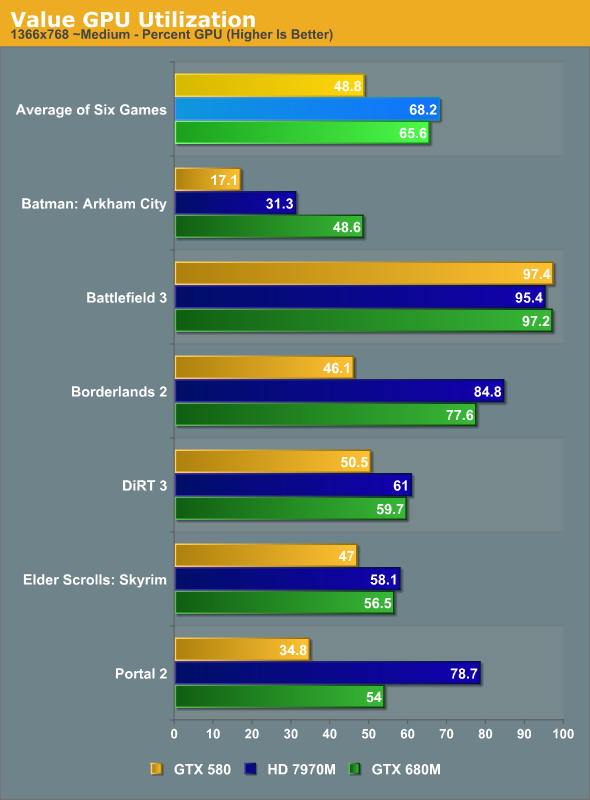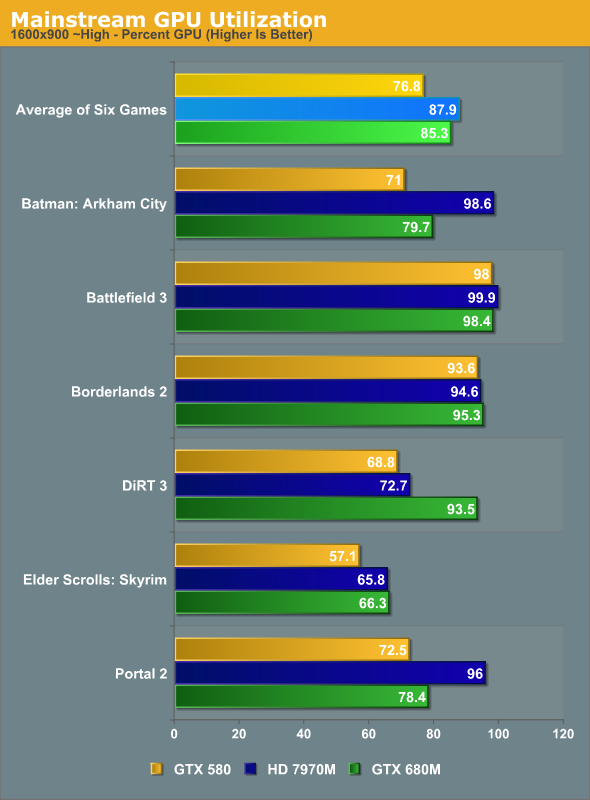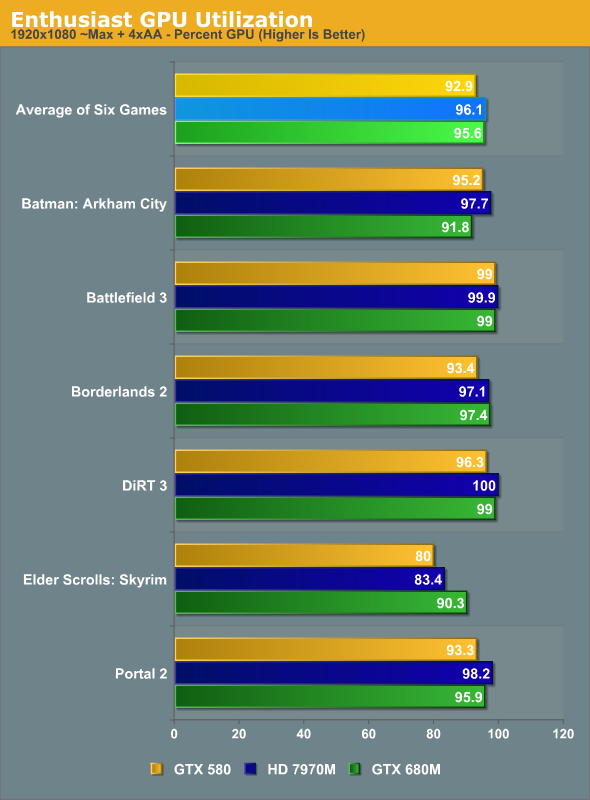AVADirect Clevo P170EM Part 2: GTX 680M Grudge Match
by Jarred Walton on October 15, 2012 6:50 PM ESTGPU Utilization Investigations
One of the issues we experienced with the initial drivers on the Radeon HD 7970M was lower than expected performance, and many users/owners of the 7970M Clevo notebooks have pointed towards GPU utilization as being the culprit. That seemed a bit odd when I first heard about the topic, as low GPU utilization should be a symptom of lower than expected performance rather than the cause—basically, if the GPU is capable of running at 150 FPS at certain settings but it’s only running at 75 FPS, you’d expect the GPU use to be around 50%. With the initial P170EM review, I did some quick checking on GPU utilization and found that, yes, it seemed low. With the Hotfix driver (which still hasn’t reached the public, though we’re hearing “this week”—meaning, some time during October 15-19), we also noted that GPU utilization did improve. Nevertheless, GPU utilization isn’t “always 90% or more”, which is what some people have been asking for.
To investigate this issue more thoroughly, I tested GPU utilization across our three benchmark settings in six of the games. For these tests, I’m not using built-in benchmarks or even FRAPS runs; instead, I played the same segment of each game in a pattern that was as close to the same as possible, and I did this over a longer segment of the games: typically at least two minutes of gameplay, with a decent amount of “action” as appropriate.
After testing the P170EM with both HD 7970M and GTX 680M, I noticed that GPU use was relatively consistent but still occasionally low. At that point it seemed that Enduro and Optimus might be the cause of lower than expected GPU utilization. The other possibility of course is that the CPU and other areas were the bottleneck and that the GPU simply wasn’t able to get enough data to work on quickly enough. To test whether Optimus/Enduro might be causing issues, I added my own gaming desktop system into the mix; it has an i7-965X clocked at 3.65GHz, 12GB (6x2GB) DDR3-1333 RAM, and a GeForce GTX 580 GPU. I ran the same gaming tests on all three systems, and here are the results:



Not surprisingly, GPU use is lower by far at the Value settings—1366x768 and ~Medium detail isn’t likely to tax the GPUs all that much, and the desktop system (with a faster GPU but potentially slower CPU) ends up with the lowest overall GPU utilization. The Mainstream testing pushes the GPUs quite a bit more, while at our Enthusiast settings most of the games are hitting 95% or higher GPU use. Looking at the games individually, we also notice that games that are typically more dependent on CPU performance (e.g. Skyrim), or at least not as demanding graphically (e.g. Portal 2), have lower GPU utilization.
I didn’t run a full set of tests using the earlier AMD 7970M drivers, but I can tell you that the Value and Mainstream results would be much lower, and even the Enthusiast settings are probably in the low 90s or high 80s on average. With the Hotfix driver installed, however, AMD’s 7970M ends up being the “best” overall at achieving high GPU utilization. I’m not sure that really matters all that much, as the real story is gaming performance. Whether low GPU utilization causes low frame rates or the low frame rates reduce GPU utilization, either way the fix is generally going to involve reworking the graphics drivers.










58 Comments
View All Comments
JarredWalton - Wednesday, October 17, 2012 - link
It's very simple to say, it's 15-20% faster, my overall experience was better, and if I were in the market for a high-end gaming laptop I would be unhappy with the [current] drivers on the AMD platform, plus the inconsistency of performance.However, if you love Sniper Elite V2 and hate most other games, I sure hope you won't just read that above sentence and assume it's an absolute fact that GTX 680M is better. That's what the rest of the review is for (all 7000 words of it). You're nitpicking over some remarks in the conclusion and suggesting I presented an "inconsistent" piece of information by discussing FPS and performance, when again the conclusion states:
"That’s a cost increase of 15% for a typical gaming performance increase of around 20% at high quality settings (e.g. 1080p 4xAA). Add to that the proven track record of NVIDIA's driver updates and for gaming purposes, that extra $200 is money well spent."
You've got a brain Krumme; use it. If you're in the market for a GPU upgrade to your laptop and you can actually get an MXM 3.0 module with HD 7970M or GTX 680M that will work in your system, obviously you're going to need to look at different pricing that the cost of an entire notebook. My statement comparing total notebook cost with the two GPUs is for 99.9% of people that buy a notebook and don't upgrade it, and I'm not going to try to appease you by dumbing it down. I'm also not going to fall for the marketing gimmick of saying, "NVIDIA is only 20% faster on average but costs 50% more!" That's blatantly false and misleading information for most people shopping for a gaming notebook. Just like I didn't compare a base model Alienware M17x R4 with a GTX 660M, 6GB RAM, 500GB HDD, 1600x900 LCD, etc. to the P170EM reviewed and say, "Wow, Alienware M17x R4 costs $1500 while the P170EM costs $2250!"
krumme - Thursday, October 18, 2012 - link
You are right. I am nitpicking and i am also constantly hysterical critical. Thats why i read Anandtech.And i dont expect you to appeace me, thats also why i read Anandtech. I know my words can be very harsh, sorry for that. I will try to improve it in my next life, as it seems i am to old and sour to change.
And i have the higest regard for the quality of the review, and especially for you beeing involved in the discussion afterwards.
I think its a strawman when you put up the statement "NVIDIA is only 20% faster on average but costs 50% more". Technically its right, and its methology right by comparing single cost to single benefit, but putting it on words is walking all over the fact that the benefit is one of the most important - ift not the most important - benefit of the rig. Then the review would be skewed. We agree.
But you argument is still comparing a - single - benefit, to the - total - cost.
I am not saying you judgement is wrong, probably for most people it is right, but you are not to be the judge. We have plenty of opinion on the net, and thats not why i read Anandtech.
An example following yours. A gamer looking for a Dell machine. He can choose between the 17r with 650 gfx or the Alienware with 660. A lot of gamer would choose the Alienware, not because of the minor difference in speed, but because of the other qualities. Even if there is a huge difference in total cost. Thats because there is way more to a gaming rig for a gamer than FPS. For what and to what degree is a personal preference. The reviewers job is to broaden the view for the reader and put numbers on the consequences.
Your conclusion negates that, directly comparing a single benefit to total cost.
Ofcourse AMD and Nvidia have two different ways they want this presented in the review. Both are wrong.
JarredWalton - Friday, October 19, 2012 - link
So what exactly would you have me say? Just "it's 20% faster than 7970M, which is a decent jump but not earth shattering. Of far more import is the driver situation. Also note that even the fastest mobile GPU right now, the GTX 680M, is basically offering similar performance to a desktop GTX 660. That's a $230 part (albeit with less memory)." That would be true, but I'm not sure it's useful unless you're wondering "should I get a gaming notebook or a gaming desktop?"Notmyusualid - Friday, October 19, 2012 - link
Well, I own dual 7970Ms, and I think Anandtech has spoken; I would have been better spending on the Nvidia solution, as opposed the AMD offering, and I won't whine about it.Not a fan-boi either way, the benchmarks speak for themselves, Nvidia wins.
Mostly mine work, but on some occasions (Shit 2) they are less than perfect.
Thanks for the review, and like the first poster said, if at all possible, could you pit Crossfire against SLI for us?
krumme - Friday, October 19, 2012 - link
You should say exactly nothing in the conclusion, and let your review stand as it is.For one gamer the 20% could be decisive for if he could play his games on the notebook at all (at native resolusion at good quality), or really make a huge difference. And you have given him the numbers.
For another gamer, the extra performance doesnt mean extra user benefits, but he can enjoy all the other qualities of the notebook. And you have given him all the details.
I know its expected in the conclusion there is some sort of judgement, - like its a boxing fight. But instead i would just point out the strong and weak sides for different users on the notebook and the gfx solution.
Regarding the enduro I would lean on the side regarding it as beta not working, and therefore something that as a start should be disabled in the bios. Its simply not a working feature yet. There is a lot of users buying notebooks, also in this class, that is not nerds. Having the feature enabled as a standard is an error in my view.
I dont know if its relevant for the readers to know that they can buy say a 660 on desktop side and get same performance.But i think its a good question. Its about putting the notebook in its context. And againg perhaps some readers dont use all their time comparing between desktop and notebook but buy either notebook or desktop from tradition. They use their time gaming instead of nerding - and they probably as a result use less money on their gear. Unlike us others who try to get as many excuses to create a need, and buy some new expensive gear.
krumme - Friday, October 19, 2012 - link
I know in the conclusion its expected that there is some final judgement like its a boxing match.But I dont expect you to say something, but let the review stand as it is.
For one gamer, the extra fps can be crusial. And you have given him the numbers.
For another, its doesnt give any noticiable difference, but he is more interested in the other qualities. And you have given him the details.
Regarding enduro, its simply not a working feature for other than nerds. And i think it should have been disabled in the bios as a standard, until the drivers are ready.
I think its a good question if its relevant to compare to desktop solutions. Perhaps, as many of your readers use their time gaming, or being in the off topic thread in the forum, instead of nerding, and therefore probably dont use so much time comparing, but buy more or less by habit.
krumme - Friday, October 19, 2012 - link
Man !Disregard the two above
TokamakH3 - Wednesday, October 17, 2012 - link
Only $170 more for the 7970 over the 7870 for a 20-30% speed increase? In a $1700 machine, that's only 10% more! What a huge bargain! 10% more money for a 20-30% performance increase! Why don't you recommend that?Uritziel - Tuesday, October 16, 2012 - link
There is certainly no logical flaw in looking at these two laptop configurations and seeing a ~20% gaming performance increase for a ~15% cost increase. Furthermore, the difficulty (and often infeasibility) of upgrading the gpu in many laptops elevates such reasoning from merely correct to obviously sensible. If this article compared two smartphones with the same numbers, would you make your same trollish complaint?Either way, it's perfectly fine to consider the performance/price ratio from both perspectives. What is NOT fine is your uncalled-for insulting of the author. His reasoning is far from 'idiotic,' and, if such reasoning IS the worst you've seen in the last ~9.5 months, I must conclude you have been cut off from society for almost that same amount of time.
I urge to you to rethink both your position and attitude in the future. Next time you might responding more like this: "Hey Jarred. I notice how you consider the performance/price ratio from a system perspective in the article. I was hoping you might include a line or two appraising it from a component perspective, as I think it would be helpful to let people know that the gpu alone follows the more traditional performance/price curve. Thanks!"
Uritziel - Tuesday, October 16, 2012 - link
"Next time you might responding..." should be "Next time you might try responding..."